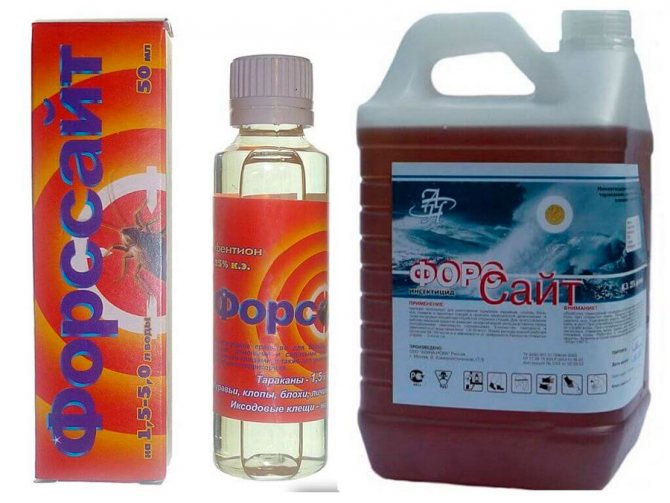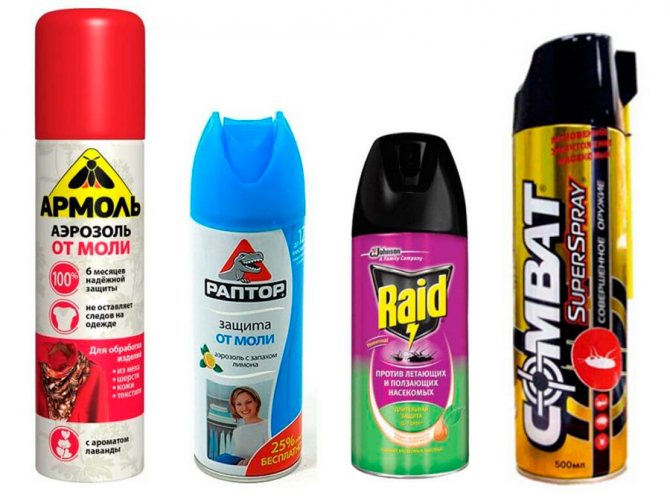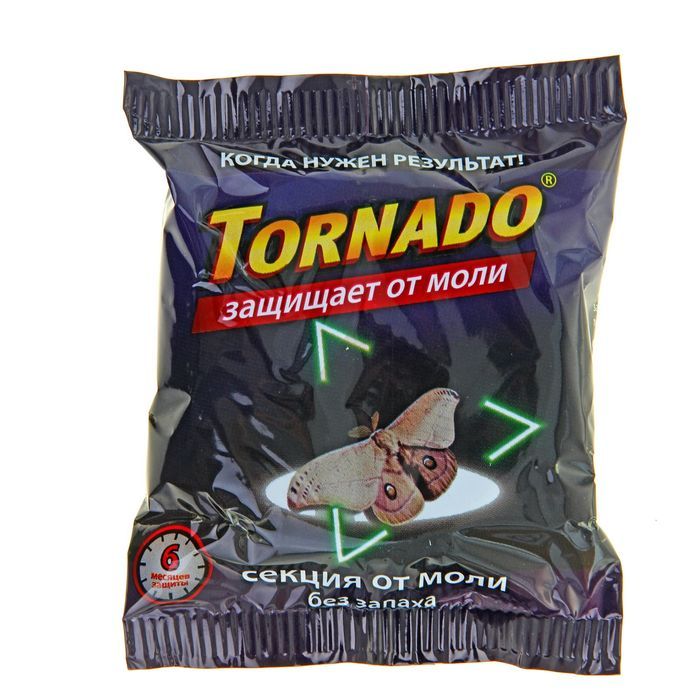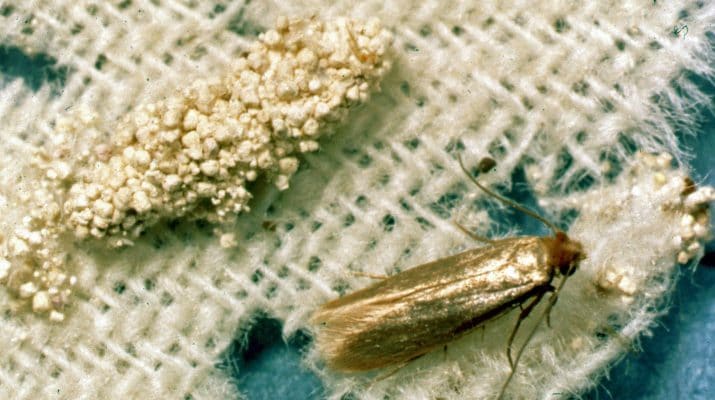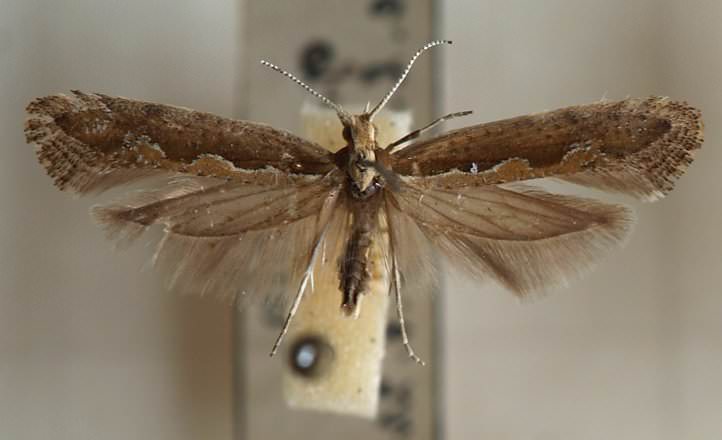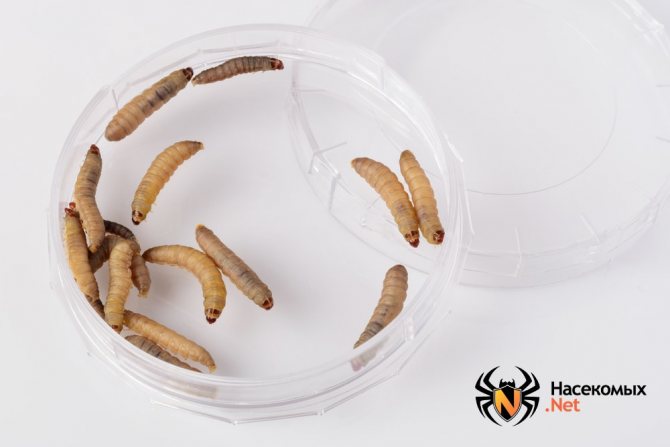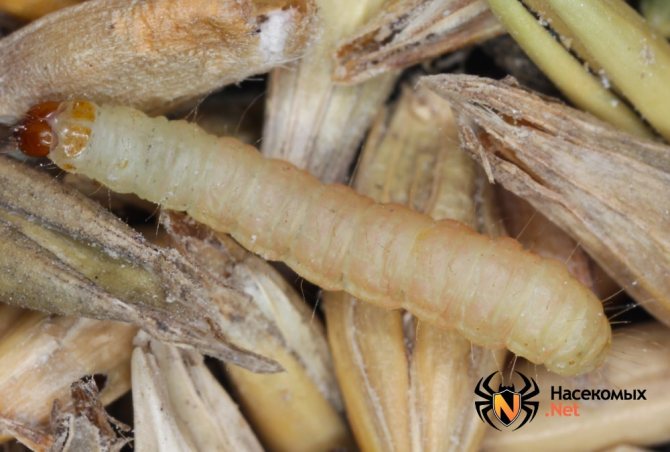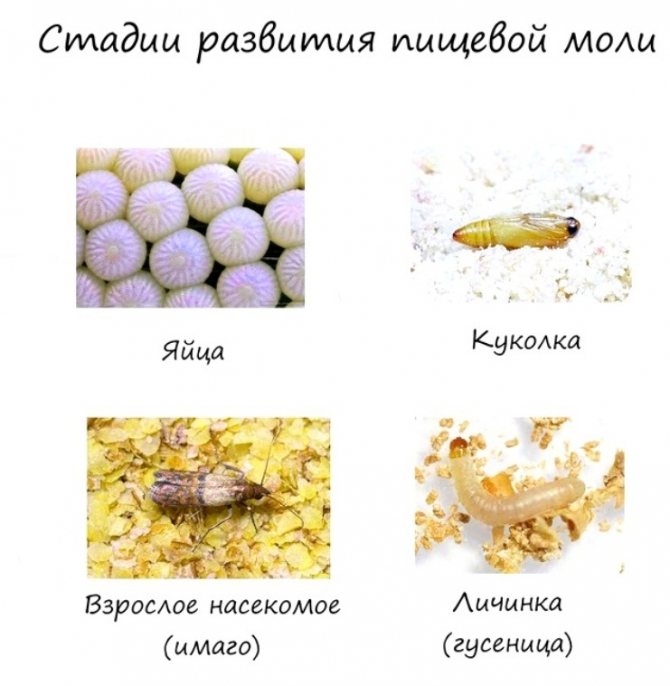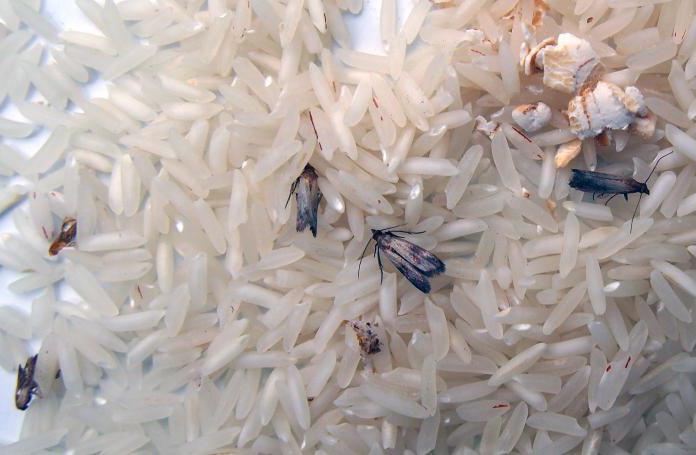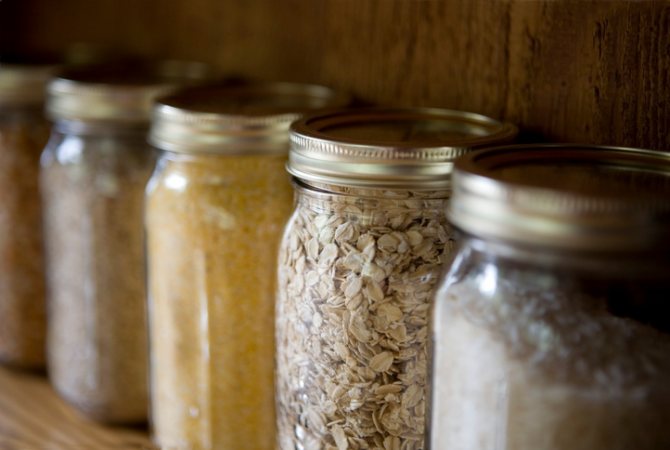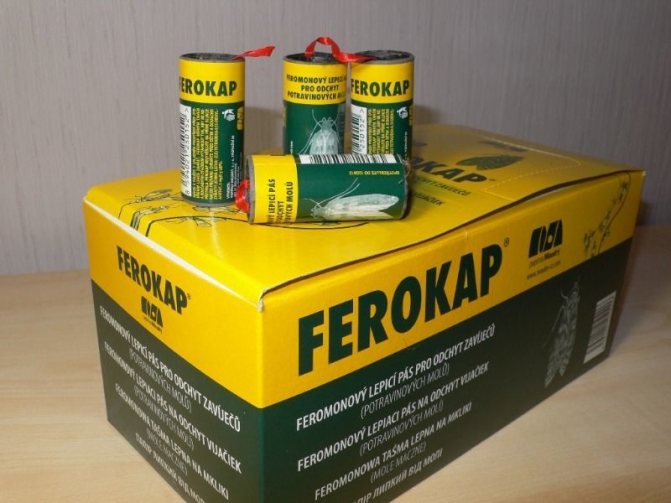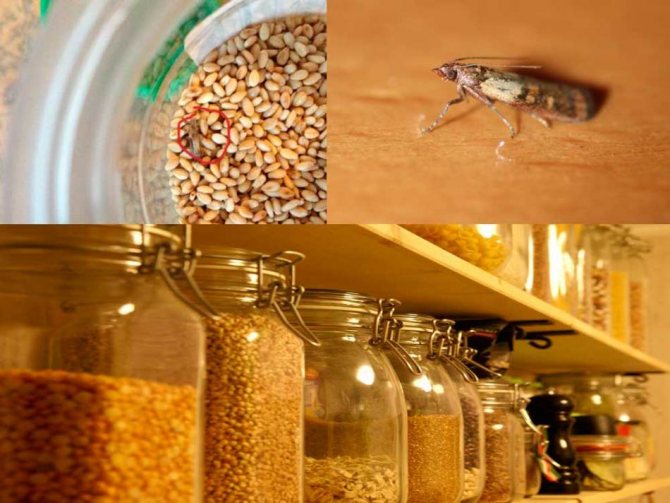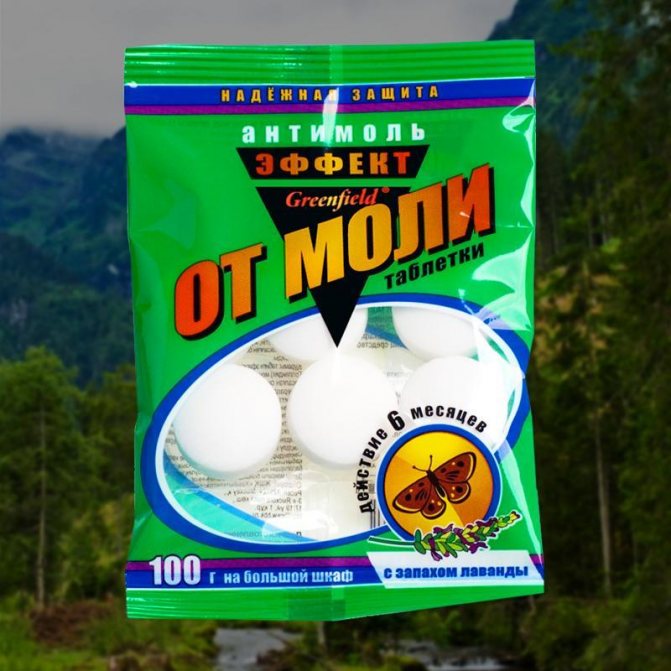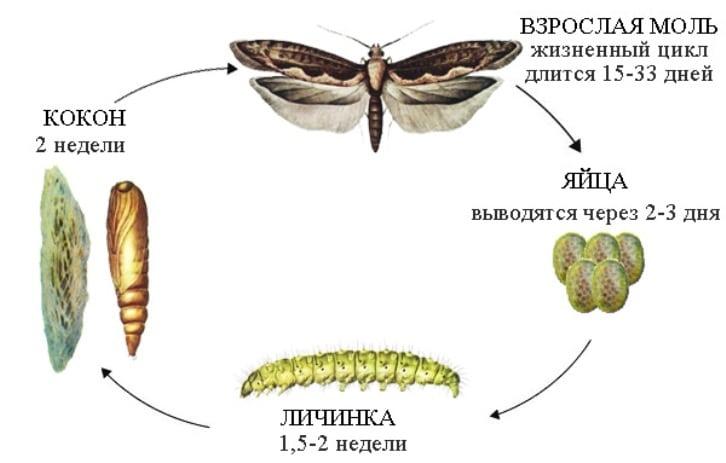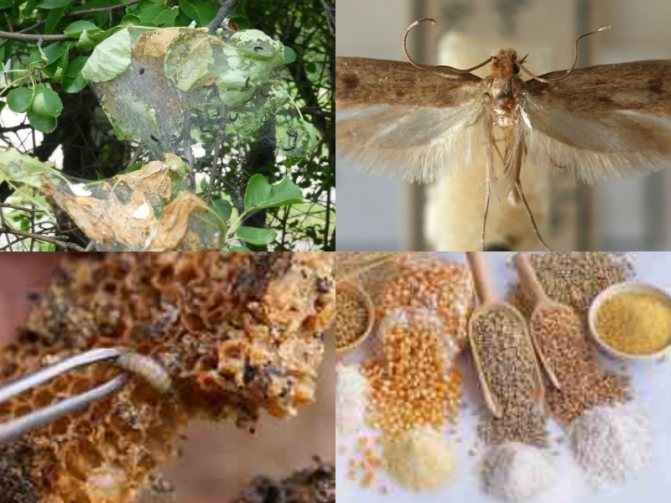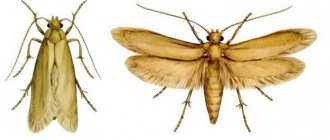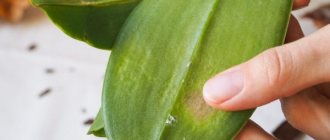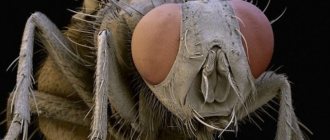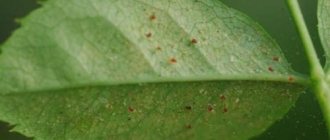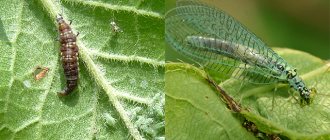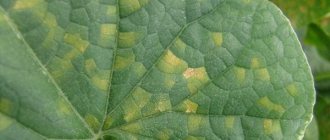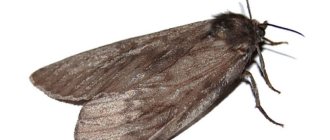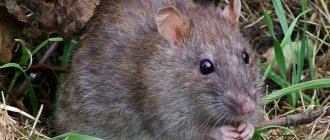Folk remedies for moths
Most of the folk remedies do not fight moths, but simply scares them away, deprives them of the desire to settle in your territory, which is also not bad.
- Arrange bunches of dried lavender, tansy, wormwood, or mint in the cupboard. You can make bags of dried grass and put them in the pockets of your fur coat. These smells will keep moths away from your wardrobe.
- He also dislikes clothes moths and the smell of dried orange peels. Place the crusts between wool sweaters and silk blouses - the moth will bypass them.
- Place geraniums on the windowsill. Its pungent smell will make the moth leave your domain.
- Essential oils such as lavender and fir are also considered good repellents. If you do not have a special scent burner, simply saturate small pieces of cloth with oil and place them in the cupboard. Remember to update the scent from time to time.
All of these remedies will definitely keep moths away from your home. But what if she has already settled with you? There is only one answer - to fight.
- Thoroughly clean all natural clothing with a brush or vacuum cleaner.
- On a hot summer day, take it outside and dry it. Under the influence of ultraviolet light, the larvae of the moth, if they could survive the cleaning, hiding in the folds, will simply die.
- In winter or during cool seasons, when there is no sun, freezing will help to destroy the larvae of the moth. Take the clothes out in the cold or, if the item is small, just wrap it in a plastic bag and put it in the freezer for a few hours. Low temperatures will kill harmful larvae.
Effective remedies
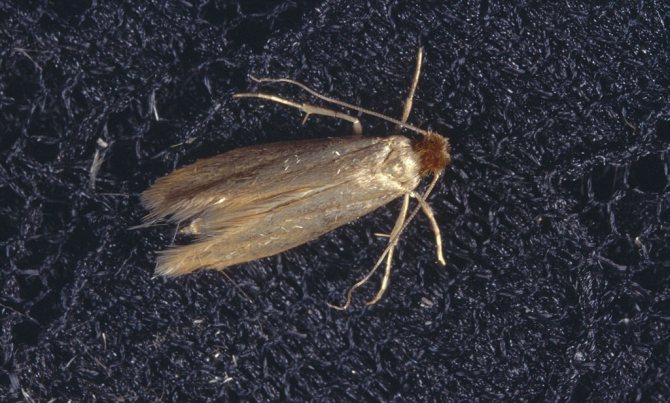
Today there is plenty to choose from.
The following formulations are good at killing moths:
- "Armol";
- "Clean house";
- Raptor;
- Dichlorvos Neo;
- "Tornado";
- Extra Meat.
Moth-affected areas should only be treated with a respirator, goggles and long-sleeved clothing. After the room has been treated with toxic substances, an unpleasant chemical odor will persist for some time. Some modern tools do not have this drawback. The room will be completely ventilated a couple of days later. To destroy the larvae of the moth, it is enough to carry out one or two treatments. Protection after using the product will last for 6 months.
Types of apartment moths
There are several types of mole depending on taste preferences:
1. Kitchen:
Granary - settles in nuts;
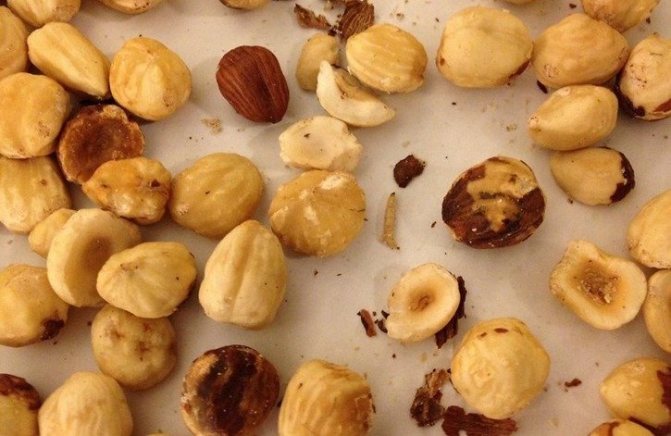

Flour - prefers flour;
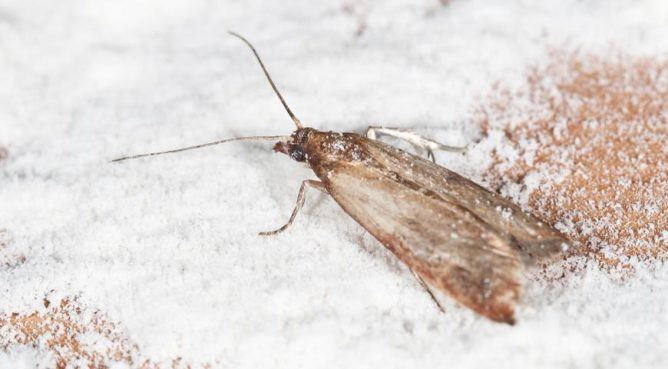

Potato - found in potatoes;
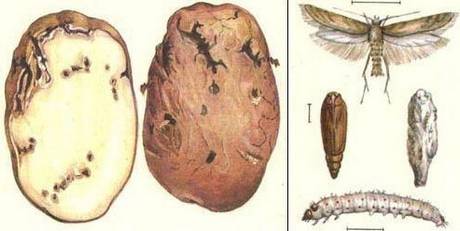

This is what an adult potato moth and its larvae look like, which settle in a potato and feed on its pulp.
Grain - lives in cereals;
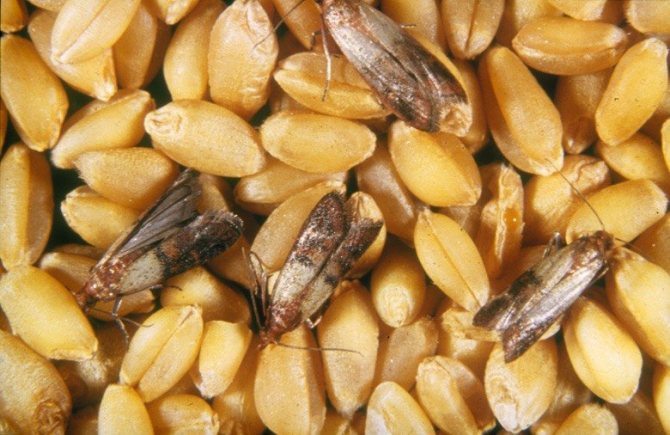

Fruit - loves dried fruits.
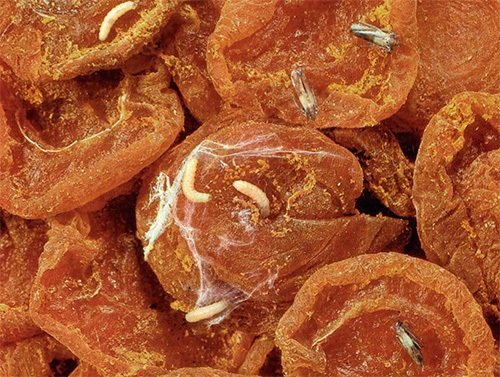

2. Room:
The wardrobe is a butterfly up to 22 mm long with light yellow wings, purple-brown at the base. It feeds on wool, which is present in outerwear, upholstery, carpets, sweaters, suits, etc. She is also attracted to pet hair and textiles contaminated with sweat, food and urine. The larvae, similar to caterpillars, hide in the folds of tissue. Clutches of eggs are located on the inside of the garment. The hatched larvae gradually gnaw through the tissue, leaving only a thin top layer intact;
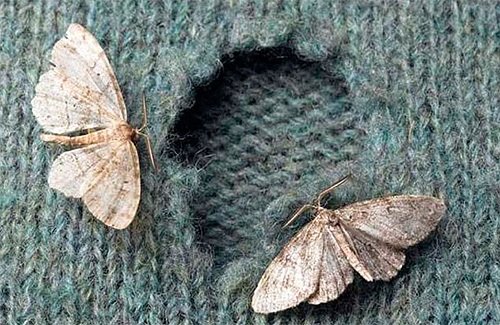

Fur coat is a small yellow butterfly with a slight sheen and a wingspan of up to 1.5 cm. The larvae have a white translucent skin, which makes them look like worms. The fur coat moth chooses felt, wool, down, fur, felt and feathers. She is very gluttonous - she gnaws through passages in everything that comes along the way, regardless of whether it is good for food. It is very simple to notice the traces of the vital activity of this pest - the fur coat begins to shed, fur fibers literally fall out of it. Adult females have the ability to reproduce very quickly;
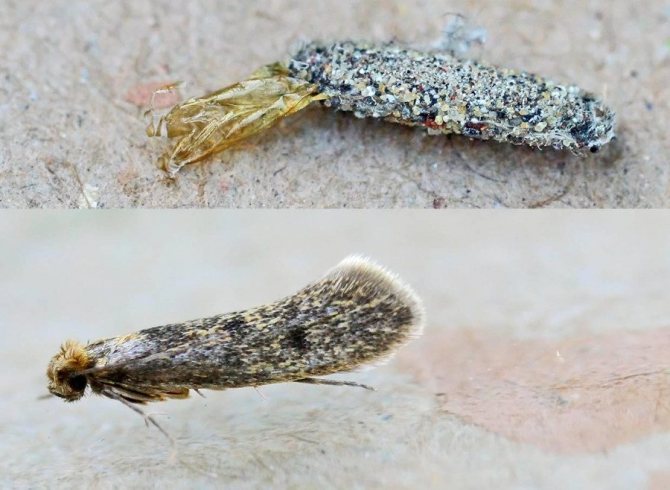

Furniture - is a small (only 1 cm) light yellow butterfly with brown wings at the base. Often settles in the upholstery of upholstered furniture, eats both natural and synthetic fabrics, so it is very difficult to deal with it. The eggs are laid in the crevices of the wood, in the bottom of the upholstered furniture and the back of the upholstery. First, the larvae eat textiles and the inner filler of a sofa or chair. Then they get to the wood, gnawing through entire passages that run parallel to the drawing;


Carpet - refers to the most resistant species of these pests. Its larvae are omnivorous - they eat with appetite fur on fur coats and collars, leather on shoes, jackets, bags and coats, as well as floor coverings. Carpet moths lay their eggs deep in the pile and other hard-to-reach areas. She is not afraid of the smell of camphor and naphthalene, therefore preparations containing these funds are absolutely useless.
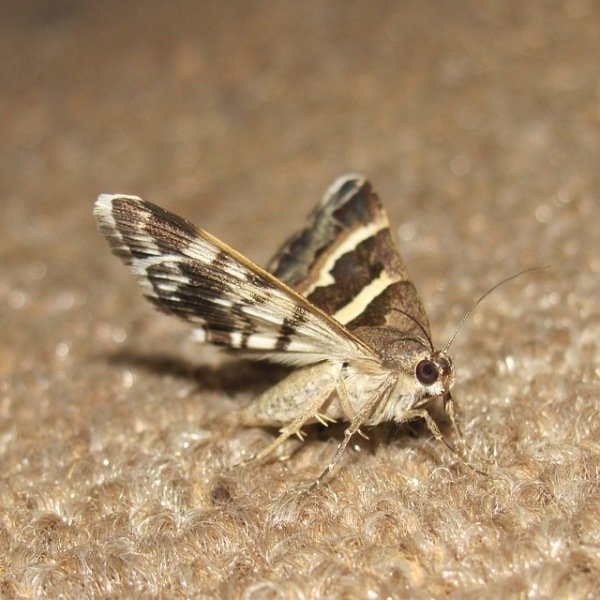

Interesting! An adult moth has no mouth, so it doesn't need food. Only the larvae cause harm. Butterflies live no more than a week, but even in such a short time they are able to lay about 150 eggs. Under good conditions (poor ventilation, high humidity and heat), these pests breed almost continuously.
What harm does an insect do?
Groceries affected by food moths become unusable and must be thrown away. Because of this pest, large food warehouses often suffer losses. Moth food supplies cannot be sold. In the course of their life and reproduction, insects leave scales, droppings and pieces of cobweb in the products. These substances are highly toxic. They can provoke severe poisoning, and therefore pose a danger to humans.
Clothes moths destroy clothing stocks in closets. In a short period, they are able to make most of the fabrics in the apartment unusable. In severe cases, they can start to damage furniture. Clothing affected by the pest loses its aesthetic appearance, and most often it becomes impossible to wear it.
Features of poplar moth
Scientifically, the poplar moth is called speckled. The butterfly received its popular name precisely because it actively spoils the life of poplars. How to recognize a pest?
You can also check out our article on controlling food moths in the home and how to get rid of them.
Appearance
A small moth with narrow wings covered with fine hairs. This pubescence looks like a fringe.
The general color is gray, nondescript. On the front wings there are brownish, sometimes with a green tinge, transverse stripes, which are noticeable only when flapping.
At rest, these stripes are more like dark spots. The hind wings are very small and faded. The wingspan is no more than 1 cm.
Poplar moth larva
Butterfly larvae are small caterpillars that have a tendency to acquire the color of the foliage of trees, which is why they are invisible.
Eggs are very small, oblong laterally flattened, yellowish in color.
Lifestyle and nutrition
It is most often found at the peak of poplar flowering. This is especially true for city dwellers, since these trees grow in many parks and squares.
Since the butterfly is nocturnal, going out to the balcony or loggia in the evening, it is very easy to find insects fluttering in the air or sticking to the walls of the house.
A special feature is the fact that insects wield flocks. He is very voracious and active. The leaf is eaten in a matter of seconds. If the year is very fruitful for moth, then baldness of trees was often noted.
Tree leaves affected by poplar moth
The mottled grass feeds not only on poplar foliage, but also does not mind eating juicy young greens of fruit trees and shrubs, as well as flowers.
Maple and aspen are especially affected by the invasion. In the field of view of the enemy - poplar pyramidal, black, Canadian. The mole will not disassemble the variety and type.
Life cycle and reproduction
The total duration of the butterfly reaches 72 hours. During this time, she must take care of the offspring.
Once a day, the mole carries out a clutch of eggs. This process occurs at the end of April, beginning of May.
Poplar moth cocoon
A week later, small caterpillars are born, the size of which reaches 5 mm. Caterpillars develop very quickly and eat everything they can on their way.
Poplar moth harm
The harmfulness of the moth moth continues throughout the summer. Their apartment life does not attract special attention, but with a huge number, they begin to fly everywhere, which means they fly into the dwelling.
This type of moth does not spoil curtains and fur coats, but is considered a pest for humans. Having penetrated into the room, they begin to sit around the interior items, leaving their excrement on them, and getting into electrical appliances, disable them. They often break computers, microwave ovens, lamps, etc.
No other harm has been identified: they do not tolerate infections, do not eat food supplies, do not spoil clothes. Moths constantly scurrying in the air of an apartment poison the lives of residents, so I want to get rid of them as soon as possible. What is needed for this and what techniques to take, we will consider below.
In addition, living in a house, moths can lay eggs in food supplies: cereals, dried fruits, flour, etc. Hatched caterpillars will be able to find food for themselves at home. These can be indoor flowers, but usually they die at home.
Adults do not feed because they have no mouth. The main task is the duration of the genus. Caterpillars are able to eat away only the pulp of the foliage, leaving behind only streaks.
Consequences of a motley attack
Often foliage can be preserved, but it clearly shows a hole with a diameter of 1 cm, which spoils the appearance of trees.
In this way, mottled caterpillars violate the landscape interior. It is known that if the number of butterflies is large, then in addition to poplars, they will destroy any park plantings.
Methods for dealing with moth larvae
Getting rid of moths is difficult, because insects at different stages of development can be in the house at the same time. And it is not easy to find a means suitable for the destruction of all its types. Nevertheless, if you periodically conduct an audit of the wardrobe and kitchen cabinets, apply exposure measures that the larvae cannot tolerate, then it is quite possible to do without chemical insecticides.


The clothes moth does not like bright sunlight, high and low temperatures, and does not tolerate some natural essential oils. On this it is worth building a line of defense against gluttonous pests of clothing:
- The larvae of the clothes moth are not fixed on things, so you can get rid of them by shaking up the woolen things over the bathroom. Then flush them down the drain so that they do not creep along the cracks.
- Washing in hot water (above 50 ° C). Only suitable for cotton or linen, which also contain moth larvae.
- Woolen items can be warmed up in summer by laying them out on a surface open to the sun's rays.Moth larvae and eggs will die at temperatures above 35 ° C.
- Caterpillars are also afraid of low temperatures. You can secure things by hanging them in the frost on the street or on the balcony.
- To destroy eggs on shelves and in the cracks of the cabinet, the inner surface of it must be thoroughly washed with soapy water.
- If you want to use a chemical remedy for moths (Raptor, Antimol, Armol), then both things and cabinet shelves are treated with an aerosol.
After getting rid of live moths, it makes sense to take preventive measures to prevent re-infestation by insects. To do this, place in the closets what the moth is afraid of. On the shelves and in the pockets of outerwear, lay out bags of dry wormwood or lavender grass, sachets with essential oils from a store or fumigator plates.
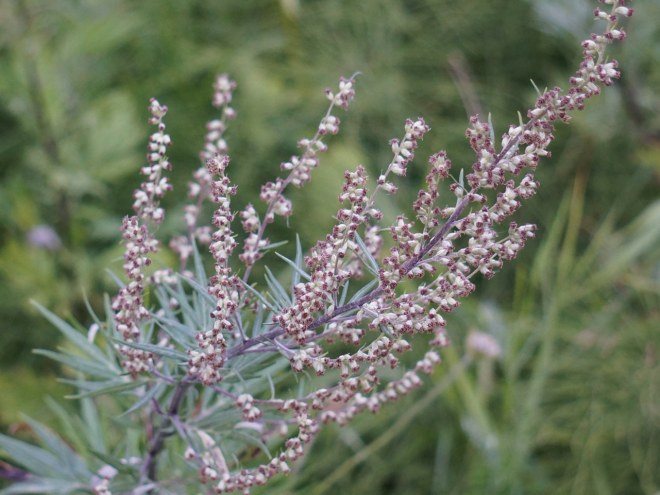

Moth larvae are removed from food products and kitchen furniture in similar ways:
- If the cereal is not severely affected, then it can be placed in the freezer for 2 days or taken out in the winter to an unglazed balcony. Then rinse and dry the small cereals, and sift the coarse ones.
- The second method of heat treatment is to fry the cereal sprinkled on a baking sheet in the oven for 10 minutes. The temperature in the oven should be 100–120 ° С.
- Wash cabinets with soapy water, then clean water and wipe dry.
- Treat the corners and joints of kitchen cabinets with a solution of vinegar in water in a 1: 1 ratio using a brush. Exposure for 1 hour is enough to kill the larvae lurking in secluded places. Then the vinegar is washed off with a damp cloth.
- Pour the disinfected products into airtight containers so that their smell does not attract new insects.
Preventing the return of moths to the kitchen is to scare them away with aromatic substances of natural origin. Garlic cloves or sprigs of dried mint, dry orange peels are laid out on the shelves. A pot of geraniums on the windowsill will also not hurt, the leaves of which can be put next to food or in clothes.


The fight against moths can take some time, it is important to show patience and not give up in order to return the house to cleanliness, and to yourself - the status of the only owners.
Control measures
What can you do to protect your home from gluttonous pests? How to get rid of moth larvae? In order for the fight against them to lead to the expected result, it is necessary to perform a number of the following actions:
- It is necessary to immediately conduct an audit on the shelves as soon as you see a fluttering moth in your apartment, since this pest multiplies quickly enough. One mole is capable of laying about 400 eggs in its life, and the entire development cycle, under favorable conditions, can keep within one month. Moreover, reproduction can continue all year round. Imagine now how many caterpillars one migratory butterfly will spawn and how many products and things its descendants will spoil.
- If caterpillars are found in food, discard them immediately. Or, if there are few larvae, you should sort out the cereals, sift the flour through a sieve, and then bake in the oven at a temperature above 50 ° C for 30 minutes. Clothes and things in which the larvae of the clothes moth are wound up are best washed at 60 ° C. If this is not possible, they should be shaken out and thoroughly roasted in the sun.
- It is necessary to carry out pest control aimed at destroying flying butterflies. An aerosol formulation specially formulated for pest control is best suited for this. The same funds are used to get rid of the larvae of the clothes moth.
- Wash cabinets with soapy water, and wipe all cracks with vinegar. Furniture and carpets should be thoroughly vacuumed.
When all these conditions are met, it is possible to get rid of the domestic moth and its larvae rather quickly, and in order to further prevent this pest from entering your house, the following preventive measures must be observed:
- keep food products in glass or plastic containers with tight-fitting lids;
- do not make large stocks of cereals, flour, pasta and the like;
- check products before buying for the presence of larvae in them;
- close the ventilation ducts with a fine mesh;
- in bags with winter clothes and shoes, put butterfly-repelling agents - naphthalene, odorous herbs, pieces of laundry soap.
Advice! Disinsection measures against butterflies and moth larvae must be carried out on the same day, otherwise new insects will hatch from the caterpillars left in the croup and all efforts will go to waste. Especially carefully it is necessary to inspect the room for the detection of pupae. They will have to be collected and destroyed by hand, as most chemicals will not take them.
How the clothes moth larva looks and moves can be found in this video:
The benefits of pests
As already mentioned, in the apartment you can find two types of butterflies - cereal and wardrobe. The nest of moths should be found in their favorite habitats:
- The wardrobe has wardrobes in which clothes are stored, as well as deep folds of furniture upholstery;
- The cereal butterfly has kitchen tables and cabinets with containers with food supplies.
So what is worth knowing about it? Sometimes a moth larva can be found in furniture. How to get rid of this pest in the sofa? Furniture moth can make a real nest from the remains of upholstery and products of its vital activity. For this reason, one of the most common methods of control and prevention is ultraviolet treatment.
After all, growing larvae prefer secluded dark places and very rarely come out into the light. To get rid of them, it is enough to place things, fur coats, hats, carpets or furniture in the sun. To prevent the appearance of moths, experienced housewives recommend putting furnishings outside on a hot sunny day.
To combat moths, it is not at all necessary to use hazardous chemicals. It is quite possible to do with proven folk remedies. They are quite affordable and have a good effect.
Popular folk remedies include:
- dried orange and tangerine peels;
- tobacco leaves;
- peppermint and lavender essential oils;
- sachet of lavender, wormwood;
- coniferous elixir;
- cedar bark;
- geranium leaves and flowers.
Adults and larvae of home moths do not tolerate harsh odors. In the absence of butterflies, reproduction stops.
Wax moth
Curiously, a moth larva can be beneficial. So, for the treatment of tuberculosis, a pest of hives is used - a wax moth. Caterpillars of this species are used as a base for tinctures and extracts of wax moths. The enzymes used by insects to break down wax have a similar effect on the tuberculosis bacillus. After exposure to the enzyme, the disease responds more quickly to antibiotic treatment.
Other species, like burdock moth larvae, are used as bait for ice and other species, fishing.
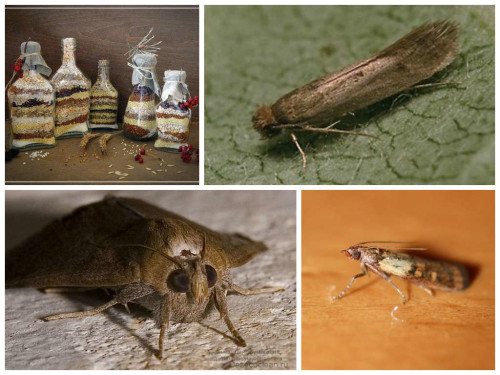

Although outwardly the larva does not look too dangerous, the fight against moths should be started as soon as the first signs of its appearance were noticed. The methods of dealing with it are quite simple and effective.
Clothes and furniture moths can be removed by treating furniture, carpets, and clothing with chemicals sold at any hardware store. After processing and keeping for a certain time, things must be washed, and the furniture must be thoroughly washed.
The larvae do not hold tightly to clothing, therefore, even with the usual shaking, they begin to fall. If things are hung out in the sun or frost, the caterpillars will die. You should deal with moth larvae like this:
- Shake up all clothing.
- Warm up in the sun or wash at a temperature of 50 degrees.
- Spray clothing and cabinets with insecticides.
- Use scented repellents to prevent insect re-colonization.
Dealing with food moths is somewhat more difficult.It is impossible to poison the larvae with chemistry, since the poison will get into the products. You should do the following set of measures:
- Throw away all packages and packages inside which caterpillars are found;
- Kill all visible butterflies;
- Treat food storage areas with aerosols from flying insects;
- Wash cabinets with soapy water;
- Do not purchase a large stock of food.
How to deal with a pest without chemicals?
This question was asked by many people concerned about how to remove a mole in an apartment. At the current time, there are a number of physical means that are used to combat moths in the house.
Flying butterflies can be caught using duct tape, which is often used to catch flies. If larvae appear or a mole starts up in food products, for example, cereals, then one of the physical ways to eliminate it is to heat the cereal in the oven for 30 minutes. The temperature should be 60 degrees Celsius.
Basic methods of dealing with moths at home
Many years of struggle with a domestic pest has made it possible to develop a set of tools and methods to get rid of moths. The most commonly used methods of dealing with moths are:
- heat treatment of a moth-infected room;
- the use of insecticidal preparations and chemicals for moths;
- destruction of moths with folk remedies;
- call for special services.
Heat treatment of the apartment
Pest insects feel most comfortable in the temperature range, which ranges from -5 ° C to + 45 ° C. If these parameters change drastically, then this will allow killing the entire brood. Thermal agents include:
- Freezing the room for several hours. This remedy will help get rid of adults and larvae.
- Steam or wash items at the maximum temperature allowed. Furniture and carpets must be treated with special household hair dryers or steam generators.
- Place fur clothes in refrigerators to get rid of moths.
These funds are quite effective and, with a small degree of infection, will allow you to get rid of moths in an apartment.
Chemicals
The best result in the fight against clothes moth can be obtained if you use effective insecticidal preparations at home on your own with the strictest adherence to safety measures. There is a rich arsenal of products on sale, such as aerosols, fumigators and repellent sections. Let's take a closer look at the line of these devices:
Moth aerosols
- Aerosol products are the most convenient to use. They help to get rid of moths with a high degree of effectiveness. The chemical composition of the drugs creates a powerful poisonous effect aimed at destroying parasites at any stage of development. Manufacturers try to eliminate the unpleasant odor of the products as much as possible by using special fragrances. The most popular are the following aerosols:
- "Armol" - has proven itself in the processing of fur and woolen products;
- Raptor is an effective remedy for moths and larvae with a residual effect throughout the year;
- Mosquitall "Protection from moths" - one of the most effective drugs to get rid of "rodents", is used to treat clothes, furniture and fabrics;
- Clean Home is an economical remedy with a lavender scent.
- Fumigators. For baiting moths, the same means are used as for mosquitoes. Their smell does not harm human health, however, it is destructive for insects and will help get rid of them. Among them, the most popular are "DiK - 3", "Raid" and "Mosquitall".
- Moth sections help scare away their butterflies, which can be used as a prophylaxis against pest infestation. The "Raptor" and "Mosquitall" sections provide the best effect.
Highly effective remedies allow you to permanently get rid of a household pest.
Folk recipes
Folk remedies for moths
You need to poison the moth quickly using effective methods. But if there are small children, pets or people suffering from allergic diseases in the house, then in this case it is best to get rid of insects by using a folk remedy for moths. People widely use plant odors against moths as natural repellents:
- dried lavender herb with flowers, thanks to its specific smell, expels insects forever;
- citrus peels, tobacco, wormwood, walnut leaves and chestnuts;
- geranium will provide peace of mind in the house;
- lavender oil applied to tampons can kill adults.
Professional exterminators
If all of the above methods and means did not help get rid of the moth and the question of how to remove the pest remains open, then you will have to seek help from specialists. Professional exterminators know how to eliminate pests quickly and with a high degree of efficiency. For the treatment of premises, they use preparations based on natural oils that have an unpleasant specific odor. Experts will competently select the remedy and carefully process the contaminated room, which will allow you to get rid of the moth forever.
Development and reproduction
The caterpillar or larva of the house moth goes through several stages of molting before becoming a pupa. The time after which pupation occurs depends on the external conditions and the type of butterfly. For example, food moth larvae develop faster than clothing caterpillars, since their diet is much richer. They are able to go all the way through development in 4-5 weeks. Moreover, the higher the temperature, the faster they will grow. Under the same conditions, the caterpillars of the clothes moth will need 2-3 months to develop.
For pupation, the larvae choose dark and hard-to-reach places, only some types of food moths are selected from the cabinets into the light. Pupae range in size from 6 to 9 mm. Their outer covers acquire a darker color than that of caterpillars and harden. Under the protection of this shell, the entire next stage of the transformation of the pupa into a butterfly will take place.
After 1-2 weeks, a gray inconspicuous butterfly will appear from a small case suspended from the wall of the cabinet. Her life will be short - about 2-3 weeks. During this time, she must have time to mate with her sexual partner, find food suitable for feeding the larvae and leave offspring.
Moth eggs are so small that they are difficult to see with the naked eye. They do not exceed 0.5 mm in length. As a rule, eggs are white and oval in shape. Under favorable conditions, the larvae hatch within a week. A newborn caterpillar has a body length of about 1 mm and a transparent skin. As it grows, it grows in size and becomes darker in color.
How does a clothes moth get into the apartment?
So where does the moth come from in the closet if everything is new, clean and neatly stacked? To find out, you should remember whether the following products have been bought recently:
- natural wool carpets
- furniture with natural upholstery
- outerwear made of fur or wool
- wearable woolen or knitted items
- shoes with natural fur.


If a mole started up at home after one of these purchases, then we can say with confidence that the larvae were already in it at the time of purchase. After settling, the moth began to multiply and spoil other things that came across on its way. Unfortunately, the pest can even be in expensive items from trusted stores that take care of their reputation.
Store-bought or used furniture can also serve as an excellent "vehicle" for transporting moth larvae to a new place of residence.This is especially true for old furniture, in which it is very easy to get to the "tasty" filler.


It is unlikely that it will be possible to completely insure against the appearance of food moths in the apartment, because to infect the kitchen, one flying into an individual or one larva in a packed cereal is enough. It is much more important to create conditions at home that will not allow moths to reproduce comfortably and spoil food.
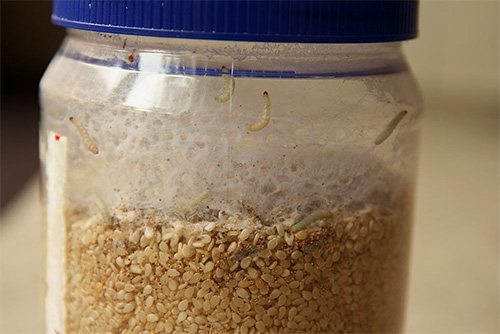

First, let's see what conditions are most favorable for food moths:
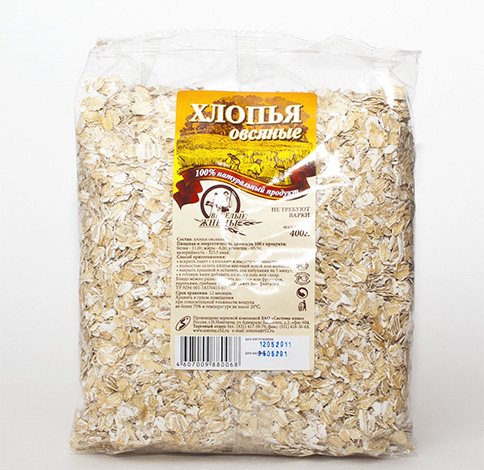

The main reasons for the appearance
They should be given special attention.
Here is a list of the most common mistakes that contribute to the spread of moths in the home:
- The hostess keeps things unwashed. Sweat stains on clothes can attract moths.
- Storage of fur products in cellophane covers.
- For a long time, the apartment has stocks of cereals and flour. Most often, food moths start up in caked semolina, flour or millet.
- Clutter in closets: If things are folded for a long time and not moved, moths can start in them.
- Inattention when examining clothes.
- Unwillingness to make minimal efforts to prevent moths from appearing. Orange peels and dry twigs of wormwood and lavender, just laid out on the shelves, help well against pests.
Where does the mole live?
lays eggs in products, from which voracious larvae appear. These products include various cereals, flour, nuts, seeds, dried fruits, pasta, sweets and cookies. The caterpillar is very small and practically does not move, so its presence in food can only be detected by chance.
Furniture moth caterpillar
dangerous in that its delicacy is outerwear made of natural wool and fur. This type of caterpillar lives in a portable case, which the caterpillar itself creates from the remnants of food and the silk-like substance secreted by its body. The caterpillar gnaws at hairs and lint, which causes irreparable damage to clothing. As a rule, this caterpillar lives in a closet and suitcases.


Although the larva of the furniture caterpillar is small in size, it has powerful gnawing jaws, with the help of which the caterpillar "shears" fur on fur coats, fur collars and hats, leaving ugly bald patches on products.
Clothes moth (room moth)
lives in houses and apartments. Its caterpillars eat cotton products and gnaw at the silk upholstery of furniture. Only caterpillars cause damage, since butterflies do not have a gnawing type of mouth apparatus.
Who is a mole is known, perhaps, to everyone. However, the danger is not the adult insect itself, but only its larvae, which are very voracious and capable of causing considerable harm.
For example, food moth larvae destroy food, clothing moths destroy textiles and furs, and burdock moths destroy garden plants. In nature, there are many species of this pest, therefore, in order to effectively combat insect larvae, it is necessary to familiarize yourself in more detail with each variety.
The main varieties of home moths are:
- wardrobe;
- food;
- wax.
Food moth has several varieties
: flour, fruit, cereal. In their way of life and structure, they practically do not differ from each other. There are only entomological differences, but they are of interest only to specialists.
In appearance food moth caterpillar larva
resembles a thick worm several millimeters long, translucent or whitish in color, the head of the worm is dark. With a sufficient amount of food, the larva can grow up to 2 centimeters. The caterpillar has six false legs: two of them are located near the head, the rest along the body.
After 1-2 weeks, an inconspicuous gray butterfly will appear from a case suspended from the wall of the cabinet. Due to the lack of a mouth apparatus
the life of the insect will be short - only 2-3 weeks.During this period, the butterfly manages to mate with the male, find a place for the successful growth and development of the larvae, and lay eggs.
In what products does food moth start?
Is there any difference between food moth and clothes moth?
The wardrobe feeds on woolen clothing or plant-derived fabrics such as silk or linen. The size of the wardrobe is slightly smaller and has a lighter color. It is easier to exterminate this type of moth, since you can treat things with a special tool, ventilate cabinets, dry-clean or wash clothes. Lavender bags or special cartridges will serve as deterrent measures.
What a food moth looks like can be seen in the photo.
She is able to start, even if the kitchen is clean. The insect flies well and is able to move long distances, because of this there is a possibility that it can simply fly towards you through a window, door or air duct. There is a danger that the larvae will survive in poorly processed foods. Therefore, when buying cereals, give preference to transparent packages so that you can view the contents of the package.
Coming from a store or market, it is possible to bring moths into the house along with groceries. Since in warehouses, before packaging, a couple of larvae can get into the bags.
And finding out where the food moth comes from is not always possible. Since it is difficult to track in what conditions the products were stored before they were sold to you, what is the situation with moths in warehouses, and how the bodies that check and control the quality of products work.
You can carefully check the purchased products, keep an eye on the cleanliness of kitchen cabinets.
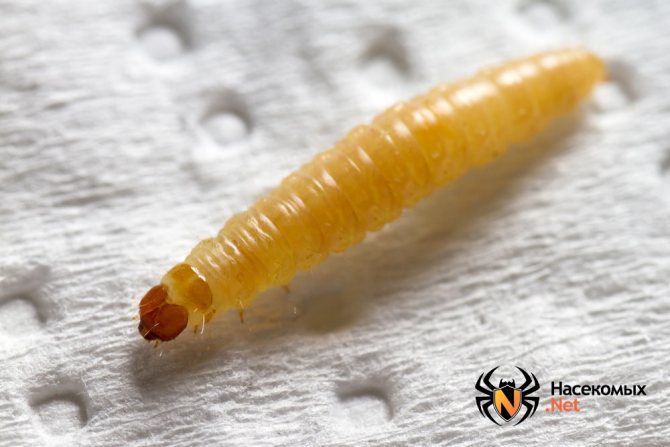

The adult individual eats practically little, but when it arrives at the caterpillar stage, it is quite voracious and can significantly harm.
Most often, larvae can be found in dry foods, cereals, pasta, peas, beans, nuts and dried fruits. In addition to feeding on your supplies, caterpillars also leave waste products behind, making food in which they have been seen unsuitable for food. The larvae leave behind cobwebs, scales, feces and other unpleasant things.
A food moth can spoil seeds for sowing, simply gnawing out the embryo. She is also able to start in sweets, seasonings, tea and breadcrumbs.
A remarkable fact. If a moth is wound up in a bag of grain, it is able to envelop a layer of its cobwebs up to 10 centimeters in depth. At the same time, the grains lose their nutritional value and are completely unsuitable for food.
Therefore, answering the question in which foods the food moth is found, there is an opportunity only to highlight a large list, which you can consider incomplete. Whether or not a mole starts up depends on the conditions under which you store your supplies.
To eliminate insects, it is not enough just to kill them. During your stay with you, an adult has probably managed to lay eggs, from which voracious larvae will soon hatch. And since we are dealing with food, the use of aerosols is dangerous to health.
To begin with, you need to inspect food products for the presence of larvae in them.
Where a food moth has already been noticed, it will be cereals or pasta, without understanding to throw it away. Since it is impossible to get rid of insects that are already in bulk products in a different way. In addition, you may not see the larvae, but the adult has already managed to lay eggs.
What is beyond doubt, if possible, ignite in the microwave or oven (for cereals), and then store in a container with a tight lid.
Cabinets in which contaminated food was stored, wipe the walls with a cloth previously soaked in acetic acid. Clean up and ventilate lockers.
One of the most unpleasant pest species is the food moth.Due to the presence of nutrients, it grows quickly enough. During the entire development period, there are four molts. If the hostess rarely disturbs the pests, they may feel at ease. They are attracted by almost everything - from dust to stale furs.
There is a moth that eats stocks of groceries stored in the kitchen, pantry, or warehouses. Such insects grow in cereals, flour, pasta and other dry foods. The most common types of moths found in the kitchen are:
- Flour. The wings are brown in color. At the base, the pattern is lighter, at the corners it is dark brown.
- Cocoa. The wings of this insect are light yellow.
- Granary. It is also called bread moth, mill moth or grain moth. Differs in grayish and straw-yellow coloring of the wings with a wide fringe.
- Fruit. A characteristic feature of the pest is horizontal stripes on the wings.
Photos of insects are presented below. All of them have a small body size - they reach 10–12 mm in length. The wingspan is approximately 8 mm. Pests move only in the dark, as they are afraid of direct sunlight. When a threat is detected, they try to hide.
The maximum life span of the pest is about three weeks. During this time, females lay eggs. The length of the larvae of food moths hatched from eggs is from 15 to 20 mm. Unlike adults, caterpillars of different species look almost the same.
The food moth lives only in grocery storage areas, so nothing threatens things, unless another pest appears in the house - a clothes moth. The larvae eating food supplies gnaw through paper or plastic bags, but they do not touch the fibers of the tissue due to the lack of enzymes that can digest them.
Ways to kill moth larvae
How to deal with moth larvae? This is a rather complex process that requires attentiveness and strict compliance with all the instructions. It takes place in several stages.
Step 1. Remove all clothing and bedding from the closets and check them thoroughly. Do not be too lazy to shake things up! The fact is that the caterpillars of the moth do not adhere well to the surface, therefore, with active shaking, they will fall to the floor. It is better to throw away hopelessly spoiled and very old clothes so as not to provoke pests to new attacks.
Step 2. Take the contaminated items out into the sun and warm them well. The main condition is that the air temperature outside should exceed +30 degrees.


To save things from moth larvae, it is enough to take them outside in the summer and thoroughly “fry” them in the sun
Step 3. If moth infestation resolves in winter, place the clothes in the washing machine and wash at the maximum allowed rate (above 50 degrees). Hot water helps kill eggs and larvae of not only moths, but other parasites as well. The wash cycle should be at least half an hour.
Step 4. If you cannot wash, try freezing. Pack your items in a clean bag and place in the freezer or out in the cold for 24 hours. True, after freezing, the clothes still have to be at least rinsed.
Step 5. Clean up the infected areas. First, the cabinets are vacuumed, and then wiped with a damp cloth soaked in hot water with the addition of a washing gel
Pay special attention to the far darkened corners
Step 6. For reliability, spray all surfaces with a disinfectant solution, insecticidal aerosol (Antimol, Armol, Raptor) or spray (Supromit, Suprozol, Neophos sprays). Treat clothing, carpets and upholstery with the same products.
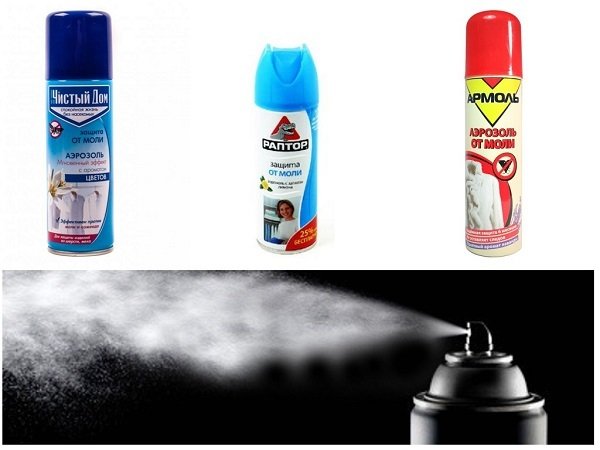

Step 7. Pack the things cleared of larvae in plastic bags. Special vacuum packages are best suited for these purposes. If some individual survives after cleaning, then without access to food it will not be able to survive.
Step 8. Arrange moth prophylaxis in the cupboard.It can be old proven naphthalene or newer preparations in the form of sections, fumigators and tablets ("Antimol" or "Moleboy"). They are impregnated with an insecticide, which evaporates and creates unfavorable conditions for the development of larvae and the vital activity of adults. An alternative to them will be special balls made of cedar wood. They contain an essential oil that kills small moth pupae. They are no longer effective against large caterpillars. If desired, you can use a bunch of dried lavender or any ether with a pungent aroma.
Prevention of moths
The best way to prevent moths from entering the room and their further reproduction is to carefully check the purchased products and regularly wash things. Other methods of dealing with these universal pests, capable of living on a very meager ration, have not yet been found. Also, take note of a couple of useful points:
- Do not buy products for more than 7 days;
- Store food in tightly sealed containers;
- Subject the purchased flour and cereals to mandatory heat treatment;
- Place fine mesh on the ventilation ducts;
- Shake purchased clothes well outside and wash.
How to find a moth nest in the kitchen
In order to remove the moth, first of all, you should find its nest. The moth nest is the very place where the maximum number of butterfly caterpillars is concentrated. Visually, the nest, if formed in cereals or flour, resembles lumps and pellets. Pieces of cereals or groceries are wrapped in silk cobwebs. There are larvae between the lumps. The walls and surface of the dishes containing the groats are strewn with white caterpillars.
Pay attention to where exactly you meet the moth most often:
- On the shelves where cereals are stored
- In the breadbasket
- In a spice box
- In a bag of sugar, in a bag of flour, and so on
If you find a nest in a grocery, check every package of cereals and pasta carefully. But the best thing is to throw out absolutely all supplies in order to precisely lime the insect. Even one or two larvae can contribute to the reproduction of moths in the future.
Useful properties of wax moth (video)
Moth larvae are terrible pests, but they also have control if you know their preferences and lifestyle.
After long-term storage of clothes, unsightly bald spots and even through holes may appear on it, the cause of which is the larvae of domestic moths. The problem manifests itself only in things made from natural materials, not artificial ones.
Such pests can be recognized by the characteristic features of their habitat in a particular environment. According to the typology of the moth, it lives not only in the wardrobe, but also in the kitchen. Cocoons can be seen on ceilings, walls and corners of open spaces.
If insects such as house moths have appeared in a dwelling, then natural textile products that are stored in closed cabinets can become their permanent habitat and reproduction. Only larvae can harm clothes. If winged individuals are seen, then this insect is already at the stage of development called "butterfly". In adults, the oral apparatus is underdeveloped, their task is different: they lay eggs, from which offspring will appear.
Experts describe these types of pests:
- wardrobe - consumes natural materials, in its diet there are such fabrics as felt, wool, felt;
- furniture - spoils the upholstery of upholstered furniture;
- carpet - eats carpets, paths, rugs;
- fur coat - eats fur products.
All individuals have wings; in females they are somewhat smaller than in males. They practically do not use their wings, most of the flying individuals are males. However, this does not prevent females from flying to new places and laying larvae there.
What is
A moth is an insect belonging to the order of butterflies. The size and appearance of an individual depends on its species.Household moths usually include clothes, furniture, grain and food moths. All their adult representatives are small (up to 15 mm) and unsightly in color, for example, gray-green, dirty brown. The insect lives not only indoors, but also in nature. For example, there are cabbage, apple, rye moths.
The way of feeding individuals also varies greatly. All larvae and caterpillars, thanks to the powerful mouth apparatus, can eat hard and solid food: stems and leaves, nuts, cereals, cabbage, beets. All moth species have their own favorite food, and it is often reflected in the name of the species. In addition, in some species, the adult does not have a mouth apparatus and cannot feed, therefore, it does not live more than a week.
These pests live near the food source or right in it, for example, in cereals, in cabbage, on an apple tree. In the beginning, a small nest always appears, where all the larvae live compactly. The nests are also within reach of the feed.
Features of different types
In the house of moth larvae, it is customary to divide into clothes and food. It is easy to understand that the first of them feed on dry goods, and the second on groceries. The moth larvae in the photo and in a "personal" meeting seem to be exactly the same, but there are differences between them.
Food moth
It is not difficult to recognize the larvae of food moths: these are small worms, white or almost transparent. The head is clearly defined, 2 pairs of legs are located on the first segments of the body, 4 pairs - on the abdomen. The length of these worms does not exceed 2 cm. The volume of the caterpillar directly depends on the type of feed that it prefers. If it is a fatty food, the food moth faces will be fat. If the caterpillar has been on a "diet", it will be very thin.
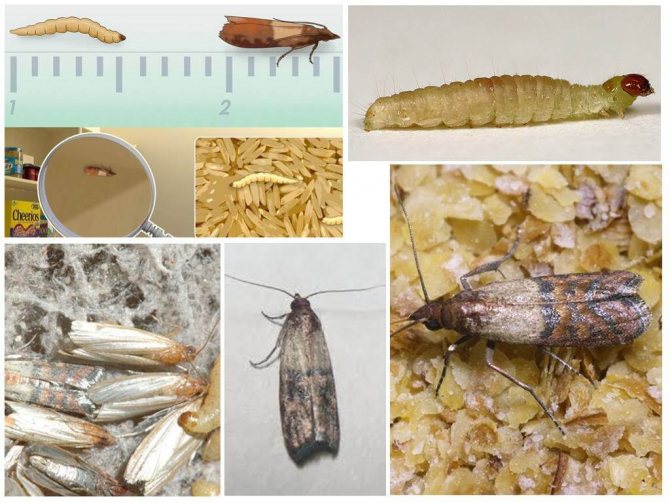

Food moth
Those foods in which it is easy to find food moths:
- Flour;
- Cereals;
- Dried fruits;
- Nuts;
- Pasta;
- Sunflower seeds;
- Candy;
- Cookies.
The moth and its larvae, which feed on food, prefer carbohydrate-rich foods. The jaws of a moth caterpillar can gnaw through even the hard shells of grains. You can find out that a pest has settled in the closet by the following signs:
- Cobweb in the croup;
- Tunnels filled with waste products of larvae;
- Lumps in fine grains and flour;
- Abandoned skins.
Larvae can be found wherever there are favorable conditions for development and suitable food. This insect has already spread all over the world, where it successfully devours products on various scales: in warehouses, in houses, in stores, at grain processing plants.
Clothes moth
The larvae of the clothes moth are similar to food caterpillars, only it is impossible to find them in the kitchen. Only items containing keratin are suitable for their food. This can be down, hair, wool and feathers. In our homes, these insects feed on:
- Woolen clothing;
- Fur coats;
- Carpets;
- Felt products;
- Natural edging on the collars;
- Feather or down pillows.
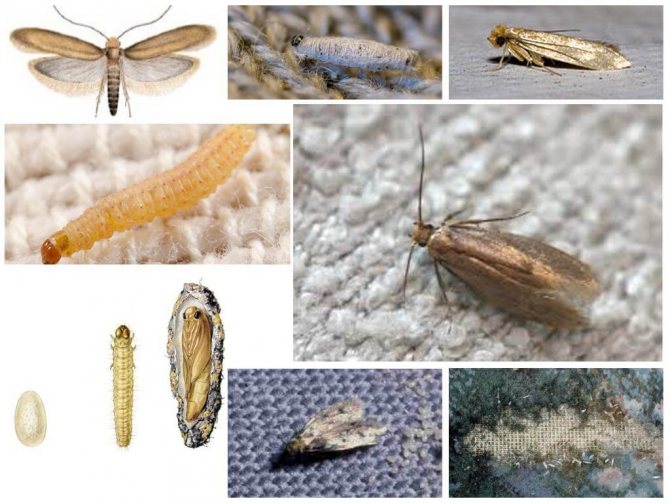

Clothes moth
Depending on where the caterpillars "graze", furniture, woolen, fur coat or carpet moth larvae differ. Similar to their food counterparts, they build their houses from what they live in: down, wool, small hairs. It is very difficult to notice a hidden larva; this can be done by indirect signs:
- Holes in clothes;
- "Bald spots" in furs;
- Pills - cocoons;
- Moves on carpets or upholstery.
Clothes moths are no less common than food moths.
Caterpillar feeding
The larvae have a huge assortment of food. In nature, the following is used:
- Wool of mammals.
- Bird feathers in their nests.
- Dead animal skins.
- Cereals.
- Fruits.
- Vegetables.
- Berries.
- Nuts.
However, they prefer to settle exactly next to a person, since food and a constant microclimate are always available in the house. For this reason, the larvae in large quantities live on human food products than in natural conditions.
How to quickly get rid of food moths in the kitchen?
For example, bee moth larvae eat honey, wax honeycomb and pergu... And the species parasitizing in the house of ants eat ant caterpillars.
Most butterflies are not specialized. Each type of moth caterpillar feeds on any food, and the clothes moth easily switches from wool to cotton. Cases have been recorded when larvae spoiled even semi-synthetic things.
Organization of food storage
As already noted, the moth enters the house with spoiled food in the form of larvae, and only then turns into insects that fly. To combat it, the following rules and recommendations should be observed.
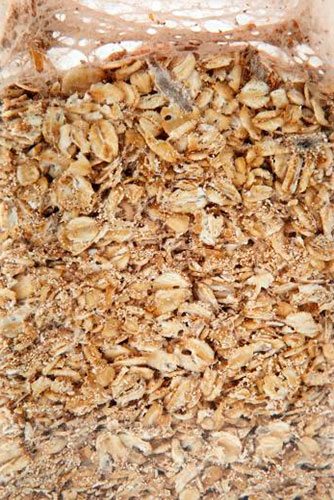

- It is imperative to look through all the food stocks in the lockers. If you find any signs of cobwebs, larvae or already adult insects, the entire stock should be destroyed. You should not buy a huge amount of products in reserve. The larvae cannot appear during storage, but if an infected batch gets in, all stocks may be damaged and they will have to be thrown away.
- It is better to purchase quality products from trusted brands. Better to pay a little more than just throw everything away.
- When buying, you should carefully consider the packaging of the product. The slightest hint of cobwebs or lumps should be a signal - you shouldn't buy such products.
- It is imperative to clean the kitchen after the destruction of contaminated products. Very often, in a product scattered on the floor or table, the moth begins to multiply further.
- When looking for a breeding site for moths, you should check every package, especially in the pantry. It is in such forgotten and nondescript bags that the main breeding ground for moths can be.
It should be noted that the name "kitchen moth" is collective for several species of butterflies belonging to the moth family. At home, there is mainly a barn or flour moth. A distinctive feature of the first individual is the presence of a light stripe on the brown wings.
How to protect your home
It is important to know how to protect yourself from moths. Prevention will help protect the apartment from pests. The following measures are worth noting:
- the use of special deterrent agents;
- checking all food products after purchase;
- purchasing only those foodstuffs that can be eaten during the week;
- do not buy products in places where products are sold at a very low price.
For moths, there is no worse herbs with a strong smell:
- rosemary;
- sagebrush;
- lavender;
- tansy.
You can also use:
- horse chestnut;
- essential oils;
- vinegar;
- orange peel;
- strawberry or laundry soap.

